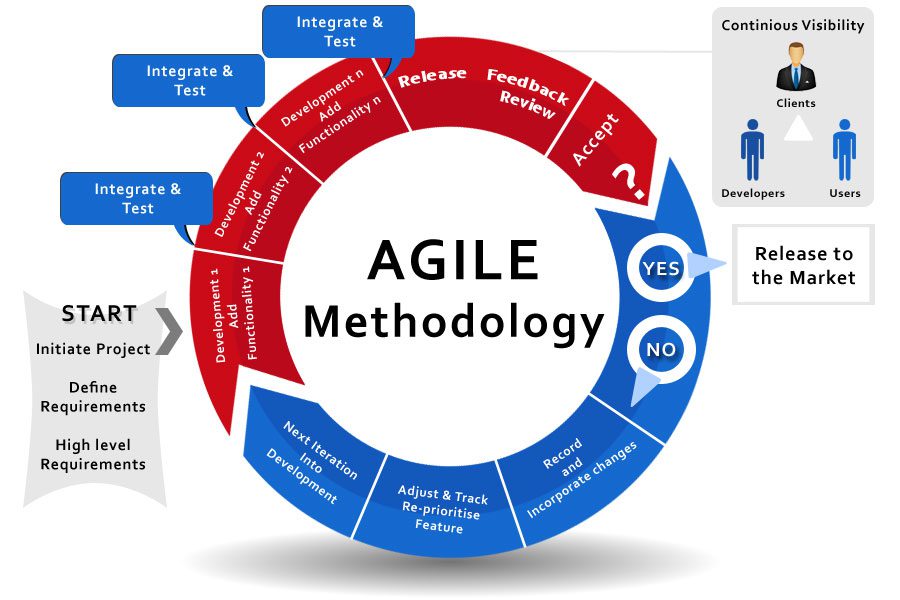
Testing is the secret sauce of software quality. Most agile teams need more solid plans, metrics, or guidelines to guide their work. One goal of adopting an agile methodology is to have developers and testers work closely together from the beginning of a project. The idea is that by finding and fixing issues early in the design process, businesses will be able to produce high-quality goods more quickly.
What is Agile testing?
Agile software development includes testing as a fundamental component. As the name implies, agile testing is a continuous process that occurs in tandem with the development phase and serves as a feedback loop for the team.
In contrast to traditional software development practices, when testing is done after the development phase, testing in an agile environment occurs before any coding has even begun.
Agile testing has also evolved to the point that there is no longer a dedicated “quality assurance” (QA) staff.
Agile development teams increasingly include testers. Every member of an agile team is expected to participate in testing instead of having specialized “testers” or “QA engineers.” In some organizations, test experts exist, but they report directly to developers and participate in their daily work.
Agile Testing Methods
Test-Driven Development (TDD)
Test-driven development (TDD) is commonly used for tests that can be executed automatically, such as unit and component tests.
In TDD, testing is the first step. When using this development method, you first decide what you want to test and then write a user narrative. First, start with a unit test.
The next step is to draw a user story. At last, you’ll put pen to paper until every unit test succeeds. TDD guarantees that all of the features are functioning correctly.
Acceptance Test-Driven Development (ATDD)
ATDD begins with feedback from actual users on new features. The first step in this form of development is to talk about the product’s intended usage. The acceptance testing phase is an everyday use of ATDD. This ensures that the product performs as intended.
Behavior-Driven Development (BDD)
TDD and ATDD are common origins of behavior-driven development. The goal of any development work conducted using the behavior-driven approach must be directly related to an expected financial return.
User stories in BDD have tests built into them, like little scenarios or requirements documents. Acceptance testing is another area where BDD is put to use.
This process ensures that the product’s features are crucial to achieving the intended results for the company.
Exploratory Testing
Any specific procedure does not constrain testers in exploratory testing but instead encourages them to go with their gut. It’s usually done by hand.
The process is documented and stored for future evaluation. And you learn as you go what it is you’re testing. It is common to practice doing exploratory testing to unearth previously unknown dangers lurking within a product. Such errors would exist if functional tests were not performed in TDD.
Session-Based Testing
The goal of this approach is to guarantee that the software is thoroughly tested, and it is similar to exploratory testing but more structured. It provides test charters to direct testing efforts and test reports to record findings for future reference. Timed sessions are used for the examinations.
Agile testing best practices
Test-Driven Development
Successful adoption of Agile test automation relies heavily on the QA and development teams working closely together to deliver test-driven development. In test-driven development, the QA team creates the automation test scripts before developing the product. Since the test scripts are based on the source code, the QA team no longer has to update them whenever there is a software update.
Choose an Appropriate Test Automation Tool
Agile test automation is challenging since the methodology necessitates constant testing to ensure the quality of frequent releases and ongoing enhancements. Choose an agile testing tool according to your needs. HeadSpin is an AI testing tool that automates testing and, with quality API, helps you to get the best testing ROI.
The Test Case User Story
The product’s implemented features, derived from the product specification, serve as the basis for the developed automation test cases. Test cases are designed using test scenarios and user stories in agile test automation. Since testers only need part of the product specification to begin automated testing, this speeds up the process.
Automation at the System Level
Changes to the user interface of an online product will occur in response to comments made by the development team and customers. When automation tests are created with the user interface in mind, they need much more time and energy to keep up and running. The middleware (or services) and system levels are where automated testing in an agile setting is most effective at preventing these problems from ever occurring. With this method, updating the product’s user interface won’t need rewriting the suite’s automated tests.
Automating Regression Test
To put it plainly, regression testing entails running previously validated test suites (or test scenarios) against older versions of the product. Assuring that changes to implementation have not disrupted previously-established functionality is facilitated by regression testing.
Test with the Customer in Mind
The QA team has to know how the end user will interact with the application, and clear and consistent communication with the consumers is a good place to start. Instead of sending mass emails, try reaching out to clients individually. This will further guarantee that the final product is of the specified quality.
Conclusion
In addition to implementing the best practices mentioned above for Agile test automation, QA teams should also embrace an Agile attitude centered on continually improving by introducing novel approaches. As Agile becomes more mainstream, more and more QA teams may benefit by following the Agile test automation best practices in their continual drive to deliver high-quality, reliable products.
